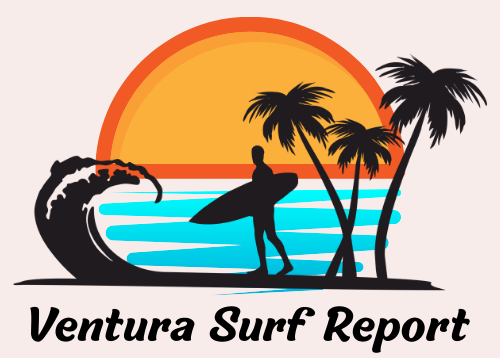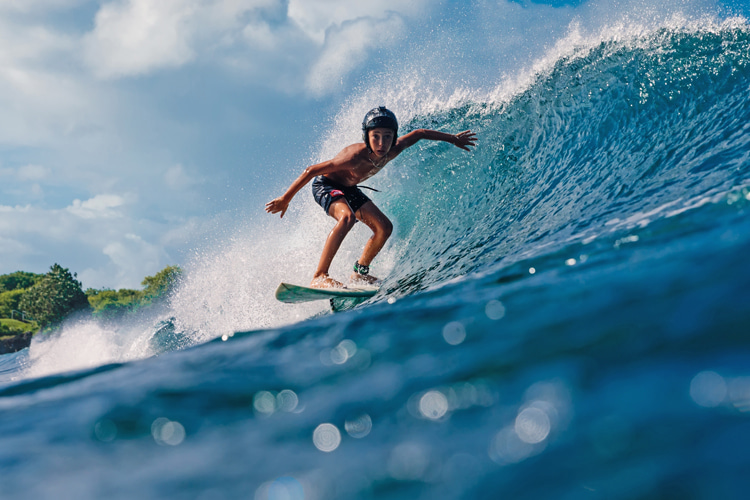
Big waves are exciting for surfers of any age, and the thrill of riding a solid, perfect overhead barreling liquid cylinder is indescribable.
Once you’ve tasted them, you’re a surfer for life – there’s no way back.
But what are your thoughts on letting children surf in more or less extreme conditions and waves of consequence?
Is there a no-go line? Where do you draw it?
And how does it compare to getting groms into any other sport like gymnastics, horseback riding, motocross, snowboarding, or even football and soccer?
More: At what age is it acceptable to allow them to add some risk to their lives? What are the boundaries of calculated risk regarding kids in a surfing environment?
As you might have noticed, there are more questions than answers.
The reason this happens is that there is always a large and broad grey area between right and wrong.
You could say, “If you’re afraid of any risk, we wouldn’t leave home and walk on the streets.”
True. But then, how do we manage children in ever-changing ocean conditions? When is it OK to let them surf?
How do you know whether you’re helicopter parenting or free-range parenting?
In 2018, “Baby” Steve Roberson became the youngest person to ride Maui’s Jaws at age 10. At only four, he rode Honolua Bay; at five, he dropped into Backdoor and, aged nine, paddled out at Waimea Bay.
Kamiel Deraeve is another fearless charger. At 12 years old, he surfed Nazaré on a big day and suffered a tricky wipeout.
In 2017, at only 15, Portuguese surfer António Laureano became the youngest athlete nominated for the Big Wave Awards.
John John Florence, for instance, tasted Pipeline when he was only five.
These and many other examples spark the debate on imposing – or not at all – limits to children in high surf.
And because nobody’s judging anyone, we’re just trying to weigh in the pros and cons, the potential red lines and dangers.
The Dangers at Stake
When we talk about surfing in general, two main life-threatening hazards pop up: drowning and the ocean floor.
Surfing in especially heavy conditions carries real consequences.
The chances of being held under for too long are higher when surfers are exposed to bigger surf.
And then, there’s always potential head and spinal injuries and psychological trauma when something goes unusually wrong.
Yes, surfing is also deeply developmental when it comes to discipline, awareness, humility before nature, respect for limits, and reading the ocean.
They are truly powerful life skills.
However, the line between challenge and recklessness is blurry. Many times, it’s more about readiness than age.
Developmental and Psychological Readiness
The concept of readiness is interesting.
Kids develop risk assessment abilities over time.
The prefrontal cortex (risk vs. reward processor) matures around 25. That said, some groms show precocious judgment, and others… don’t.
In other words, some children are more cautious; others have a kamikaze streak – but both can be coached.
That said, exposure to challenge and a moderate dose of fear is good, but if a kid is scared and overwhelmed in consequential surf, it can lead to long-term psychological barriers.
Fear of the ocean and trauma loops are a couple of issues that could impact children.

“Dad, Can I Go Surf Pipe?”
So, what are some of the questions parents could ask their kids (and themselves) before allowing them to paddle out in waves that clearly pose dangers?
Here are some of them.
Do they understand the potential dangers of rip currents, wave sets, and getting caught in the impact zone, and how can they deal with them intuitively and comfortably?
Can they handle a long hold-down, a two-wave set, or a snapped leash?
Can they breathe through panic and stay calm underwater?
Are they truly asking to go out, or is it ego (theirs or their parents’)?
Is there a backup safety net, such as a jet ski, rescue swimmer, lifeguard, other surfers, or swimmers watching, in case anything does not go according to plan?
Are the big waves breaking in shallow water over a coral reef or rocky ocean floor?
Where’s the “No-Go” Line?
In most circumstances, parents or equivalent representatives are legally responsible for the underage’s actions.
That is valid if they cause harm to others, but also to themselves, if gross negligence is proven.
So, when presented with the option to allow a teenage surfer to paddle out in extreme ocean conditions and XXL waves, parents can be conservative and say “No” or just trust their liberal instinct and say “Do it.”
Ultimately, there is no single rule, and each one of us has a different view on these complex decisions.
There are some universal, common-sense boundaries regarding interaction with the ocean and waves of consequence, though:
- Never let a child paddle out into conditions they can’t self-rescue from;
- If they don’t yet fear the ocean, they probably shouldn’t be in waves that deserve fear;
- If they freeze or block in a wipeout scenario, they’re not ready for waves of consequence;
- If they’ve never taken a three or four-wave hold-down, even in small surf, maybe don’t start with heavy eight-foot barrels;

Guidelines for Letting Kids Surf Big
If you’re a mother or father or you’re legally responsible for a minor who wants to step up their game in sizable surf, you can always at least follow a few fair enough guidelines.
Start with graduated exposure. Get your kid to progress steadily from beach breaks to reef breaks and only later to controlled bigger days.
Give your surfer child full agency. If they hesitate, it’s OK – no ego burns.
Teach them or ensure they know the fundamentals of breathwork, how to relax after a more severe wipeout, and how to spot when they’re out of their depth.
Also, have clear rules: paddle out only after watching the biggest set marching in and detonating in front of them, and only if they feel confident about their backup or emergency plan.
Let your children watch and absorb – groms learn fast by watching older, better surfers. The more they do it, the better they will mimic the veterans’ best safety practices.
Lastly, and this is very important, your kid should be very aware that if it all becomes about proving something, it’s time to pause.
Because that’s exactly when things can go sideways.

Loose Reflections
Assessing risk and finding the balance between hazards and risks and fun and healthy play varies from parent to parent.
There is no precise line between good and bad judgment. After all, everyone is just wanting their kids to experience life to its fullest.
Surfing seems to get judged harsher when a grom gets sent into a big day – maybe because the ocean is less controllable and more unpredictable than a football field or climbing wall.
Some of the world’s best surfers were in serious waves when they were very young.
The thing is, they probably had daily access to surf, safety professionals, and watermen nearby, deep ocean education, and consistent exposure to many swell patterns and their consequences.
Traditionally, the duality between “Pushing it” and “Allowing growth” is often about intention and vibe.
We could probably ask ourselves whether our kid is innately attracted to the waves or being thrown into them.
Oftentimes, parents tend to push their love of surfing to their children.
They want them to experience the thrill of walking on water the same way they did. And while that is perfectly understandable, many times, too, it works the other way around.
We’ve got to keep in mind that surfing is unique because you don’t control the environment – only your preparation and your mindset.
Therefore, risk is inevitable.
Our goal is to teach kids to dance with risk intelligently, not avoid it or glorify it. Only then will surfing be the healthiest and most fulfilling sport in the world for the ones we love the most.
Words by Luís MP | Founder of SurferToday.com


Leave a Reply